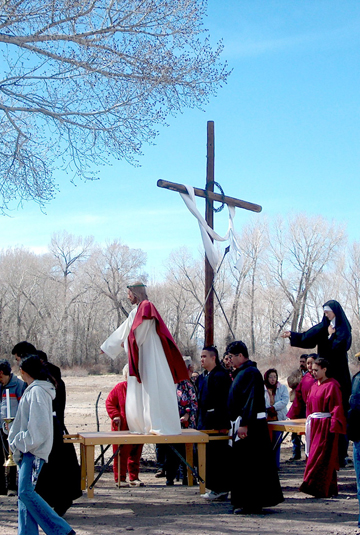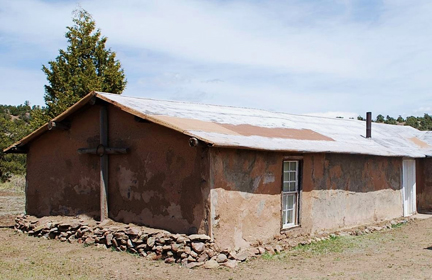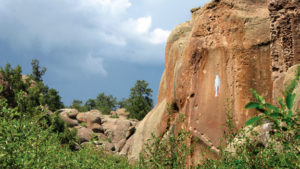Understanding the Penitente Church in Southern Colorado and Northern New Mexico
by Ruben E. Archuleta
Slowly and methodically the candles on the candelabrum are extinguished one by one as the Hermanos (Brothers) recite their prayers and sing the mournful alabados (Penitente hymns) until the last of the thirteen candles is out leaving the morada (meeting place) in total darkness. Suddenly the pandemonium that ensues with the sounds of rattling chains, the staccato of the matracas (wooden noise makers), banging on tins, and the wailing brings to mind the shaking of the earth, the lightning and thunder, the fear and wailing of the people gathered around the crucifixion … and then darkness as Jesus’ mortal body releases its soul. The Penitente rite known as the tinieblas (darkness), which represents the death of Jesus on the cross, has been practiced every Good Friday evening in the moradas throughout southern Colorado and northern New Mexico for over a century, and possibly longer.
This rite is one of very few that is open to the public by the society known as La Fraternidad de Nuestro Padre Jesus el Nazareno (The Fraternity of our Father Jesus the Nazarene). The membership consists mainly of Hispanic, Catholic laymen who are devoted to the teachings of the church and Jesus. Women were also involved in the society as members, but mostly as auxiliaries, who supported the men’s activities during Holy Week. These auxiliaries were known as Carmelitas, Veronicas, Auxiliarias and Paduanas.

The origins of Los Hermanos Penitentes (The Penitent Brothers) have been debated by scholars for decades. Some believe they originated in Europe in the thirteenth century or in the American Southwest when Spanish explorers made their way from New Spain into the area that is now known as Colorado and New Mexico. It is believed that in the early 1900s there were between 15,000-20,000 members in the Fraternidad, and in 1947, when the Catholic Church officially accepted and recognized the Fraternity, there were approximately 10,000 members. Currently it is estimated that between 1,000 and 1,500 Hermanos are still active. At one time chapters could be found as far north as the Fort Lupton, Colorado area, however these numbers have dwindled due to the passing of aging members. Much like memberships in other organizations such as the Elks, Masons, and American Legion, the Society has found that the new generation of young men and women are hesitant to join and commit their time and effort.
Much has been written about the Penitentes; unfortunately many writers from the late 1800s and early 1900s wrote with a bias that portrayed the Brotherhood as cult members who spent most of their time whipping and crucifying themselves. Being a humble society that believed in the act of humility, and facing close scrutiny by the Catholic Church and the public’s insatiable desire for sensationalism, the Brotherhood opted for seclusion and secrecy which more than likely stimulated more interest in the Brotherhood.
[InContentAdTwo]
The Penitentes did practice certain physical rituals during holy week. The most common of these rituals included flagellation with whips made from yucca or rope, the carrying of a madero (a heavy wooden cross) around the Stations of the Cross, and binding a Penitente to a cross. These rituals symbolized the whipping of Jesus before he carried the heavy cross to Mount Calvary where he was crucified. Other less known rituals were carried on during the initiation of novices into the Brotherhood, and as punishment of those individuals who strayed from the rules and ethics practiced by the Hermandad. Members of the Society were expected to be exemplary members of the community and devout Catholics who practiced and obeyed the teachings of the Church. Violations of the Brotherhood’s rules were dealt with quickly and harshly.
According to a member of a morada near San Luis, Colorado, the rituals involving physical penance waned during World War II when young Hispanic, Penitente males were drafted to serve in the military. These young men, while taking their physical exams, were confronted about the scars on their body which they still bore from their initiation and Holy Week rituals. This information was corroborated by a 1941 article that appeared in the Huerfano County News which detailed the account of a young man from the Walsenburg, Colorado, area who had been drafted. The article told of how young Benny was questioned by military physicians about the numerous scars on his back. Benny explained that he had received the wounds while performing the rituals as a member of the Penitente chapter in Huerfano County. Several members from various moradas claim that the physical rituals are no longer practiced, but no one will know for sure since all the members are sworn to secrecy.
With the exception of a few authors like Marta Weigle and Alice Corbin Henderson, others failed to recognize the everyday acts of charity that the Penitentes contributed to their membership, their families and their community. Handwritten journals reveal the dedication and sacrifice that were very much a part of the Hermanos daily life. Entries from the early 1900s in the journal from the Morada de Los Pinos, New Mexico, detail times of hardship and personal problems that were addressed by the membership to ease their member’s burdens. Members would donate whatever money they could afford, and if they couldn’t help monetarily they would donate food items, labor, and the use of their horses and wagons to provide firewood for those in need. If a member had legal problems, the membership would fund legal representation to assure that the member received fair treatment. Monetary and spiritual support was common throughout the chapters in Colorado and New Mexico.
One of the other rites that are open to the public is the Encuentro (Encounter), a procession which takes place on Good Friday. The procession varies from one morada to the other. In Arroyo Seco, New Mexico, the Hermanos gather at the morada where they are joined by future novices and women who belong to the auxiliary known as the Veronicas. The Hermanos, wearing their divisas (ribbons), form the procession with one of them carrying a crucifix. As they walk from the morada to the church, the Brothers sing alabados (praises) and recite the prayers which have been recited for decades by their ancestors. As they near the church the procession is joined by families, worshippers and the curious who come from all over New Mexico and other states. The procession ends at the church where everyone gathers for services.
In San Antonio, Colorado, the procession is a little different. The Hermanos, their families, participants and onlookers gather at the morada. One of the Hermanos wears a white robe with a maroon sash and a metallic crown of thorns. Four young men, who may or may not be Penitentes, are garbed in black robes with hoods. These men will be carrying a heavy, life-sized statue of Jesus on a platform from the morada to El Calvario, the site representing Mount Calvary.
Meanwhile at the church, not far away, the Veronicas have gathered with the parish priest, relatives, and other participants. The Victorias, dressed in maroon hooded robes, will be carrying a life-sized statue of Mary from the church to El Calvario. At a specified time the Hermanos, the Veronicas and their processions start their journey to El Calvario, which is halfway between the morada and the Church. The Penitente procession is led by a horseman representing a Roman soldier, in a black robe carrying a colorful banner. As the procession winds its way along a dusty road through sagebrush, volcanic rock and adobe houses, the Hermano Mayor (Elder Brother) leads the participants in song and prayer. A few of the Hermanos read from their cuadernos (handwritten prayer and hymn books), some of which belonged to their ancestors. Along the way to El Calvario the procession passes a grotto, a natural niche in the volcanic rock, which houses a statue of the Virgin Mary.

The Veronicas are also led by a horseman with a colorful banner. The parish priest leads them and the other participants in prayer and song. The statue is heavy and the strain is visible on the faces of the young women. The procession turns from the main road onto the dirt path lined with a row of adobe homes. The Penitentes and the Veronicas meet at El Calvario. A tall, heavy cross with symbols from the crucifixion marks the location where the Encuentro has met for many years. The cross is adorned with a barbed wire crown that symbolizes the crown of thorns worn by Jesus, steel railroad spikes that represent the spikes used to nail Jesus to the cross, a spear that pierced the side of Jesus as he hung on the cross and a pole with a sponge on the tip that has been dipped in wine.
As both congregations meet, the Hermanos recite prayers from their cuadernos. The Hermano representing Jesus, garbed in the white robe, meets reverently with Mary, who is represented by one of the Veronicas dressed in a maroon robe. Mary pleads with Jesus, asking him why he is going through all the pain and suffering; and now the crucifixion which he is about to face. Jesus responds that he is going through all the agony for the sake of mankind and soon his ordeal will be over and he will be sitting at the right hand of his Father. After the prayers the Hermanos, the Veronicas and the participants part into two groups. One group proceeds towards the morada where they will take part in the Stations of the Cross. The other group accompanies the parish priest on the pilgrimage from San Antonio to Our Lady of Guadalupe church in Conejos where they will gather and pray.
During Holy Week, traditional Lenten meals are cooked throughout the Hispanic Catholic community. Since abstinence from meat is part of the fasting regimen for Lent, colorful, tasty meals are cooked using dried beans, peas, chili, wild spinach and eggs. Frijoles (pinto beans) are cooked in a large pot while arvejón maduro (dried yellow peas) simmers in another pot. Meanwhile beaten eggs with a dash of baking powder are deep fried and served with red chili. Quelites (wild spinach) sautéed with a little bit of diced onion and spicy chile caribe flakes, and fresh flour tortillas complete the meatless, delicious meal. For dessert the choices are sopa (bread pudding), a pudding dessert called panocha made from sprouted wheat grain and brown sugar, or the traditional biscochitos (sugar cookies).
Although the number of members and active moradas are declining in some areas, others are thriving. Some of the moradas in southern Colorado that still have active members can be found in the areas of San Antonio, Garcia, San Luis, Fort Garland, Agua Ramon, Walsenburg, and Trinidad. Other moradas which have closed down range from the areas of Fort Lupton, Avondale, Gardner, Longs Canyon, Engleville, Higbee, Trinidad, Maes Creek, San Francisco, Monte Vista, Los Lobatos, Los Rincones, and other small towns and villages too numerous to mention.
The most active moradas are located in areas of northern New Mexico in communities like Arroyo Seco, Abiquiu and Tierra Amarilla. The number of abandoned moradas far exceeds those still active, but scholars, the public and families of the Penitentes have shown a renewed interest in this fascinating society. The children and grand children of once active Penitentes have found a new sense of pride in the Fraternidad.
Ruben E. Archuleta has published four books; the autobiographical I Came From El Valle; Land of the Penitentes, Land of Tradition, based on the handwritten journals of his grandfather and great-grandfather; Eppie Archuleta and the Tale of Juan de la Burra, a biligual book based on the world-renowned Colorado weaver and Penitente Renaissance, Manifesting Hope, which includes photos he took while doing research on the Penitente. He is also a sculptor and photographer and lives in Pueblo, Colorado.


Thank you for the interesting article. Can you give details on when this takes place in San Antonio and whether we could respectfully observe the ceremonies at San Antonio and Conejos?
Ruben, you are one great “ARCHULETA” I went though the menu
and you have a great collection of good reading material.
Going back to Asensio Arechuleta I suppose we can call each other – Primos…we need more Spanish Authors!!! Wishing you greater knowlege…Elroyo
As I was growing up in San Acacio, Colorado, I remember going to the Morada in San Pablo, Colorado with my brother-in-law’s father and family, Senor Patricio Sanchez from Canon de Chama during Holy week. Everyday and every night we had to pray the rosary at his home and we knelt for hours praying for all the living and then for all the dead, name by name. We did not dare to move well in prayer, ask my sister who is married to Patricio’s son, Floyd. At that one time in remembrance, my sister Debbie was kneeling on a small rock that just happened to be on the linolium. I will always remember the look on her face when we were finally dismissed from prayer.
Those will always be beautiful memories for me during the time of the morada and helping Karen Sanchez, daughter of Patricio Sanchez in cooking for the men.
Also about 18 years ago, I remember on Good Friday walking from San Francisco (El Rito) to San Luis with groups taking turns carrying the cross and singing alabados and praying. The people from San Luis had booths along the 10 mile walk giving the gente (people) water and goodies so they could keep their strength to continue walking to the church along with Father Pat Valdez. This was my very first time walking with my Tio Checho (Floyd Martinez) de San Acacio and a memory I will always cherish. Once we arrived at the church, we gathered inside with more prayers and then we continued our walk to the Shrine of the Stations of the Cross on the Mesa, overlooking the Valle of San Luis. With each station, stopping in prayer and singing until we reached the top of the Shrine and into the most beautiful chapel were we ended our prayers for Good Friday.
I wished that all the young people now adays could experience the beautiful culture of Holy Week and participate in the times of the morada. I am 52 years old and live in Denver, Colorado but the memory of those days will always remain in my mind and in the heart of the people of El Valle as well as in mine.
Thank you Mr. Archuleta for the wonderful article of the Penitentes because it brought back beautiful memories of so many people who have gone to serve the Lord.
Respectfully yours,
Wanda Rael (Daughter of Alfonso and Theresa “Martinez” Rael)
Dear Mr. Archuleta,
This was a wonderful article. I would like to request your permission to print the procession photograph you include here in an exhibition catalogue of the work by Colorado artist Emilio Lobato. He grew up in Alamosa, Colorado witnessing these religious processions and this photo would illustrate them beautifully. I would credit you of course.